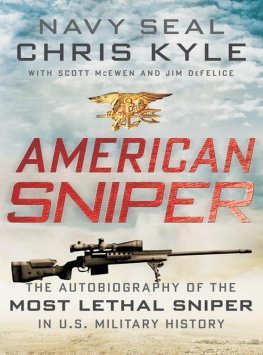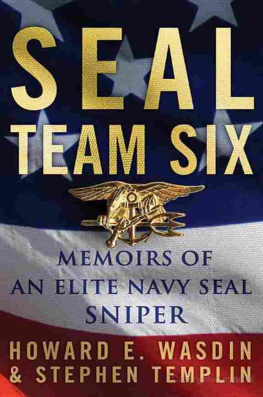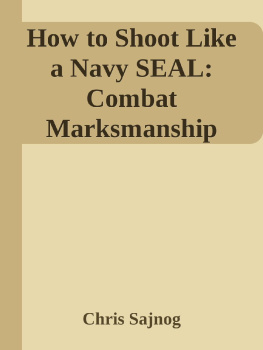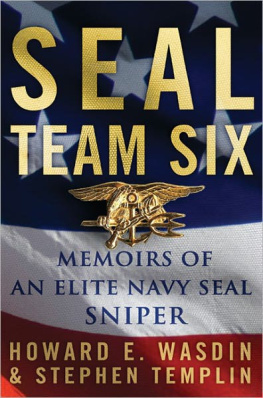Copyright 2013, 2016 by Glen Doherty and Brandon Webb
Foreword Copyright 2016 by Don Mann
A version of this work was previously published by Skyhorse Publishing in 2011 under the title st Century Sniper
All rights reserved. No part of this book may be reproduced in any manner without the express written consent of the publisher, except in the case of brief excerpts in critical reviews or articles. All inquiries should be addressed to Skyhorse Publishing, 307 West 36th Street, 11th Floor, New York, NY 10018.
Skyhorse Publishing books may be purchased in bulk at special discounts for sales promotion, corporate gifts, fund-raising, or educational purposes. Special editions can also be created to specifications. For details, contact the Special Sales Department, Skyhorse Publishing, 307 West 36th Street, 11th Floor, New York, NY 10018 or .
Skyhorse and Skyhorse Publishing are registered trademarks of Skyhorse Publishing, Inc., a Delaware corporation.
Visit our website at www.skyhorsepublishing.com.
10 9 8 7 6 5 4 3 2 1
Library of Congress Cataloging-in-Publication Data is available on file.
Cover design by Brian Peterson
Print ISBN: 978-1-5107-1415-1
Ebook ISBN: 978-1-5107-1416-8
Printed in China
CONTENTS
FOREWORD
Next to BUD/S (Basic Underwater Demolition/SEAL Training), SEAL sniper training was the hardest school I ever went through. The stress and pressure the instructors put on us during our training was intensebut necessary. There are some great sniper programs in the U.S. military, like the USMCs Scout Sniper Course and the armys Special Operations Target Interdiction Course (SOTIC), but the SEAL Sniper Course is a very different animal. It is one of the worlds best programs.
Never has the sniper been more relevant to our military than it is today in the twenty-first century. As I describe at some length in my own book, the threats, environments, and missions modern snipers face in the course of the Global War on Terror are very challenging. And thats putting it mildly.
As Brandon and Glen mention, few books on sniping are written by actual snipers, and its about damn time that changed. These guys have been through the training and done the work in combat. They do a great job of giving you a glimpse of the snipers world: history, weapons, gear, great pictures, and a personal perspective. Even better, they tell it in plain and simple English.
In American Sniper I shed some light on the sniper community and tell the greater story of sacrifice and teamwork involving all warfighters on the battlefield. After all, its about teamwork and working toward a common objective. The lone sniper can deal a massive blow to the enemys psyche, but a sniper cannot win the war alone. It takes a team, and these guys understand that.
Enjoy a peek behind the curtain.
Chris Kyle
Navy SEAL sniper and bestselling author of American Sniper
FOREWORD TO THE 2016 EDITION
In todays Global War on Terror, snipers are more relevant than in any other time in our nations history. Glen Doherty, one of the four Americans tragically killed in the Benghazi Consulate attack on September 11, 2012, and Brandon Webb provide a unique and very exciting glimpse of the brutal physical and mental training and missions that todays Navy SEAL Snipers endure.
From the moment I checked into my first SEAL Team, (ST-1), I quickly gained an appreciation of just how hard our SEAL snipers worked, how meticulous they were not only in shooting but in everything we did as SEALs. They were quiet, intense, and always so very professional. Our snipers were as skilled as every other SEAL in all other aspects of the duties of a SEAL but, in addition, they were the snipers for the team, the over-watch and the eyes from above.
Snipers are routinely tasked with making life or death decisions for unsuspecting men, woman and children. These snipers have to process a great deal of information before making the decision of pressing that trigger back and launching a round that would take the life from another human being.
All SEALs and other warriors are trained for combat, trained to kill, et cetera, but it is somewhat a different story for a sniper when he can clearly see the expressions on his victims face as he fires his lethal round.
The selection process of becoming a SEAL sniper is incredibly challenging. Basic Underwater Demolition/SEAL (BUD/s) is known as the most difficult military training in the world and produces the finest warriors on the planet. It has always impressed me just how frequently so many highly trained SEALs do not pass the arduous three-month SEAL sniper course.
Selection as a SEAL sniper is based on a multitude of factors including: marksmanship and stalking abilities; proficiency in the arts of stealth and concealment; an exceptionally high degree of mental focus and concentration, intelligence, and decision making abilities; and the mental and physical capacity to crawl through and set up on target for hours or sometimes days through jungle, desert, mountain, arctic, and urban war-zone terrain.
But, to put it all in perspective, the sniper selection and training process does not compare to the realities that a SEAL sniper faces when operating in a war zone. Training is just the beginning. The test is combat. No matter how proficient our SEAL sniper instructors are in making training realistic, there is no way to train a person for actually making the shootno-shoot decisions and dealing with the consequences of those decisions.
It is very difficult for most people to comprehend the scope of dealing with the life and death decisions these snipers routinely make. How do they cope with taking the shot without having 100 percent assurance the person was a threat? What happens to the psyche of a sniper after he has killed a person, ten people, or one hundred or more people?
Snipers generally have a similar mindset regarding the taking of lives. Chris Kyle, the Devil of Ramadi, who served four tours of Iraq and has 160 confirmed kills and 255 probable kills, is the most accomplished sniper in US history. Chris stated that every person I killed, I strongly believe that they were bad. Chris claimed to have no regrets and referred to the people he killed as savages. He stated that, When I do go face God there is going to be lots of things I will have to account for but killing any of those people is not one of them.
In 2003, during Chriss first tour as a sniper, he was tasked with being the over-watch for Marine battalion in a terrorist-rich Iraqi town. As locals gathered around the Marines during their movement, Chris observed a woman with a child approach the Marines. She had a grenade in her hand. This was the first of many life and death decisions Chris faced as a sniper and was his first kill of many more to follow. He was forced to make a quick decision, but in Chriss view, She made the decision for me, it was either my fellow Americans die or I take her out.
There have been countless studies that show that snipers tend to empathize with their victims as real people and are less likely than other soldiers to dehumanize their enemy. Most soldiers in todays wars refer to the enemy as terrorists, but snipers generally referred to them as human beings or even as legitimate warriors.
This might be because snipers often see their victims with great visual clarity and often observe them for hours and sometimes days. Although a sniper shot is often made from a distance it can become more personal than killing in typical combat.










